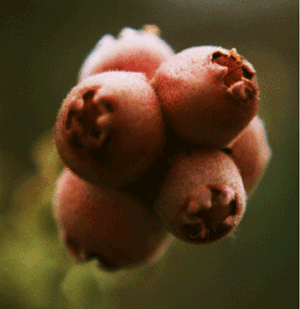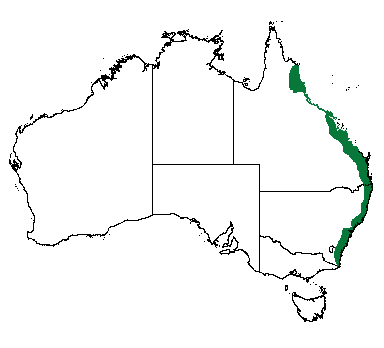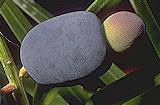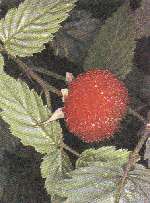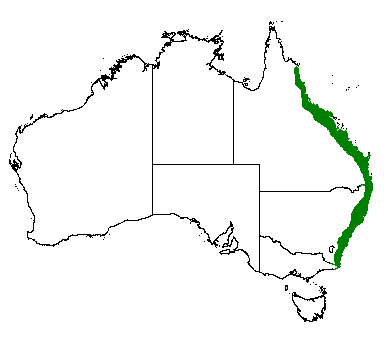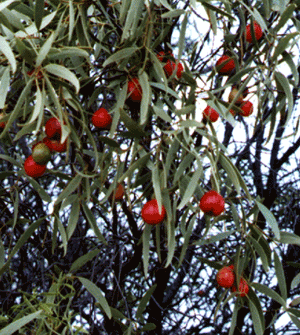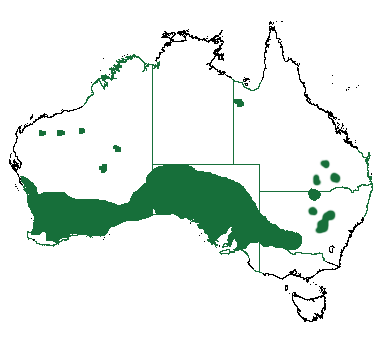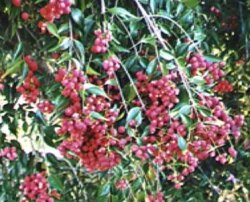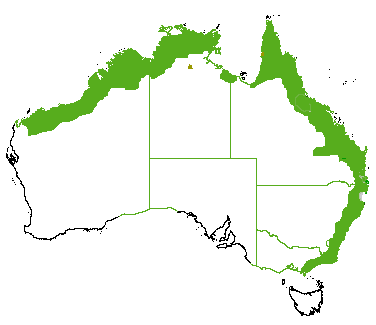Fruits - 'G-S' |
|
|
| Planchonella australis | Pleiogynium timorense | Podocarpus elatus |
| Rubus spp | Santalum acuminatum | S. spicatum |
| Santalum lanceolatum | Solanum centrale | Syzygium spp |
|
|
||
Kunzea pomifera |
|
Muntries, Muntharies |
|
|
Family |
Myrtaceae |
General notes:Small, crunchy berry with a deliciously sweet apple flavour from the south-east of South Australia. It has small, green and red fruits with a Granny Smith apple flavour. Edible portion:Fruit Harvest period:Summer Yrs to maturity:2-3 Form:Low shrub or ground cover Natural Distribution/Growing conditions:SE SA and SW Vic. Light textured soils with good drainage Climatic/microclimatic conditions:500-800mm rainfall areas Management reference:Berry. Moderately tolerant of frosts, salinity, lime soil, coastal exposure and drought. Fruit size is variable and clonal selection suggested. Partial shade is suggested to enhance fruit size and flavour. Prefers light textured, well drained soils. A handful of organic fertiliser such as blood and bone on planting and side dressings Spring and Autumn suggested. Traditional Aboriginal UseFruit eaten Density:2mx3m - 1650/ha (under irrigation) Yield at maturity:1.5 kg/plant Harvesting:Hand Supplied as:Fresh, frozen, dried. Typical value adding:They compliment apples in pies, flans and desserts providing that visual difference and make excellent sauces and garnishes. It can be used fresh. Current purchasing price:$22/kg (frozen), $35/kg fresh Perceived demand:High Further information, supply of plants:Brian King Muntari Wildfood Plants of Australia Ph: 0888 472 542 Fax: 0888 472 540 From the RIRDC ReportCultivation of Native Food Plants in Southeastern Australia
Munthari survival was quite variable between sites and also within sites. Rows of munthari
often contained a number of vigorous healthy plants and also a number of failures alongside
them. Quite a number of plants were lost, more so at some sites than others, yet the vigour
of surviving plants was often very good, especially for “Rivoli Bay”. This suggests that there
are problems with seedling establishment that may be caused by soil-borne fungal diseases
or soil-borne pests. We can test this by attempting to replant in the same spot to see
whether the establishment problem recurs. Links |
|
Planchonella australis |
|
|
Black apple |
|
|
Family |
Sapotaceae |
General notes:Heavy fruiting does not occur annually. The fruit is purple-black, like a small mango or large plum, and 4-8 cm long (60 g). The flesh ripens to a soft, purple pulp useful in jams and desserts. The marketability of Black Apple fruit is very good, although limitations arise from slow seedling growth. Trials of grafting mature scion wood to seedling rootstock are being undertaken to attempt to overcome this problem. Edible portion:Fruit Harvest period:Early summer Yrs to maturity:10+? Form:Large tree Natural Distribution/Growing conditions:Subtropical, littoral and dry rainforest, Illawarra to Gympie Climatic/microclimatic conditions:Subtropical Traditional Aboriginal UseFruit eaten Management reference:Not suitable for fruit fly areas as you can't spray. Cultivars not yet commercialised in significant numbers. Density:Unknown Yield at maturity:Fruit production from mature trees is large (up to several hundred per season), although variable between years Harvesting:Hand Supplied as:Fresh or frozen Typical value adding:Unknown Current purchasing price:$NCT Perceived demand:High Links |
|
Pleiogynium timorense |
|
Burdekin plum |
|
|
Family |
Anacardiaceae |
General notes:Great variation in fruit quality and size. The fruit can be as large as a golf ball or small as an olive. It has thin flesh around a large stone and a mild apricot-flavour. Edible portion:Fruit Harvest period:Autumn - Spring Yrs to maturity:3-5 Form:Medium to large tree (depending on local conditions) Natural Distribution/Growing conditions:Dry rainforest from N to SE Qld. It can also be found on sand dunes behind mangroves and in dry sub-coastal vine scrubs. Open soil and sunny position is preferred. Climatic/microclimatic conditions:Dry tropical to subtropical. Some frost tolerance Management reference:Stone fruit. Male & female trees needed. Density:Unknown but could be treated as a large tree (300-400/ha with adequate rainfall or irrigation) Yield at maturity:Unknown Traditional Aboriginal UseFruit eaten Harvesting:Hand Supplied as:Fresh, frozen Typical value adding:Pickling, sauces, compotes. The whole plum pickles well in hot vinegar flavoured with native herbs. Current purchasing price:$NMV at present Perceived demand:Low Links |
|
Podocarpus elatus |
|
Plum pine |
|
|
Family |
Podocarpaceae |
General notes:The fruit is really the enlarged stalk or peduncle - blue-black and plumlike in flavour, with a pleasant yet subtle resinous quality. Plum sized, it conveniently carries its seed outside of the fleshy portion of the fruit. Often used as a street tree. Edible portion:Fruit - 20-30mm. Early, mid and late season varieties exist. Fruiting can be variable. Harvest period:Mar - Jul. Early, middle and late season varieties exist. Yrs to maturity:5 Form:Variable - mainly a large tree - larger under cultivation than in the wild. Stated there is great variability in height - from5m to 35m - 5m to 10m under cultivation. Natural Distribution/Growing conditions:Warmer rainforests, coastal from Cairns to Illawarra NSW on a wide range of soils. Climatic/microclimatic conditions:Tropical, subtropical to temperate high rainfall regions. Moderately frost tolerant. Management reference:Male and female flowers on separate trees. Females only fruit. They require one male tree per ten female trees approximately. Seedlings have a wide genetic variability Some trees noted to bear well above the stated 6kg (at 5 years). Mildly frost tolerant. Traditional Aboriginal UseFruit eaten Density:Spacing - 6m x 6m = 275/ha - lower for dryland cultivation Yield at maturity:6kg/tree Harvesting:Hand Supplied as:Fresh Typical value adding:Can be sauced and performs extremely well with chilli or ginger, complementing our game meats. Preserves, cheesecakes, muffins and other desserts can be made from the plums. This fruit behaves in a similar way to gooseberries in turning bitter with overcooking, the bitterness disappears on cooling and we suggest using stainless steel saucepans for simmering. Current purchasing price:$6-8/kg Perceived demand:High. Also a valuable cabinet timber species. LinksANBG http://www.anbg.gov.au/anbg/conifers/podocarpus-elatus.html Daleys http://www.daleysfruit.com.au/bushfood/plumpine.htm |
|
Rubus fraxinifolius |
|
Atherton raspberry |
|
|
Family |
Rosaceae |
General notes:Sweet, edible, red fruits. Similar to exotic rubus but little work has been done on selection for size and flavour. There are seven different native raspberries but all of them suffer, to one extent or another from either insipidness, dryness, tartness or hard seeds. However, I have come across some exquisite R. parvifolius so selection for fruit could be undertaken. Edible portion:Fruit Harvest period:Late summer - autumn Yrs to maturity:1-2 Form:Prickly, mounding shrub with stems to 1m. Natural Distribution/Growing conditions:Found along the east coast from Vic to N. QLD. They are hardy in most soils in sun or semi-shade and prefer moist conditions. Climatic/microclimatic conditions:Temperate to tropical Management reference:Berry fruits. They can be trained as a climber and need to be pruned often. Large scale trellis plantings could be replaced by edge plantings in suitable positions. Traditional Aboriginal Use:Fruits eaten Density:As for raspberry if trellised Yield at maturity:Seems to be variable from plant to plant and season to season. Likely 2kg/plant in good conditions: Harvesting:Hand Supplied as:Fresh, frozen, pulp or juice Typical value adding:Treat as you would the raspberry Current selling price$12-$15 /kg Perceived demand:Growing LinksDaleys http://www.daleysfruit.com.au/bushfood/Athertonrasp.htm SGAP QLD http://www.sgapqld.org.au/article37.html ASGAP http://asgap.org.au/r-pro.html |
|
Santalum acuminatum |
|
Red quandong, Desert Peach. |
|
|
Family: |
Santalaceae |
General notes:My thanks to AQIA (Australian Quandong Industry Ass) for their invaluable information. There are 5 recognised species of Santalum in Australia. The members of this genus are root parasites in that their roots attach themselves to the roots of other plants and gain part of their growth requirements from the host species. S. acuminatum is probably the best known Australian member of the genus as it is an important bush food in the drier areas of the country. It has a plum-sized, glossy red fruit with a large stone and a delicate apricot crossed with rhubarb taste with a slight touch of cinnamon. The kernel contains valuable proteins and is rich in oil. It is one of the most well-known bushfoods to be commercially grown in Australia. The kernel contains valuable proteins and is rich in oil. Rather dry texture discourages eating fresh but dried fruit is more palatable. There is large genetic variability in seedlings and thus selected stock is suggested. See also "DOOR for Quandong" (pdf) Edible portion:Fruit, kernel Harvest period:August- December Yrs to maturity:5 Form:Small tree or spindly shrub, up to 5 m. Natural Distribution/Growing conditions:See following. Climatic/microclimatic conditions:150-600mm rainfall areas. Management reference:Refer to the AQIA notes which follow. It is found in a range of soil conditions and climates, with varying water quality. Best results come from planting with a northerly aspect in well drained soil with existing root systems present. Protect from wind and fertilise with slow release Osmocote or similar (approx 1.6% phosphorous) at rate of 5-gms per plant. It tolerates highly saline soil, limestone and drought but can be set back by root disturbance when planting out. Avoid heavy textured soils, areas which become waterlogged (even for short periods of time) and chemical fertilisers with greater than 3% phosphate. Quandongs are partial parasites. They grow sucker-like attachments onto the roots of other plants to extract nutrients. They utilise a number of host plants such as strawberry clover, being trialed as hosts. When planting out, the quandong and the host should both be planted. While quandongs are adapted to growth and survival in arid to semi arid conditions, young plants must not be allowed to dry out. Propagation by grafting onto seedling stock is becoming more common as particular forms are selected for their desirable fruiting characteristics. Seed is apparently difficult to germinate and the inherent genetic variability of seedlings make it wise to purchase selected clonal stock. Traditional Aboriginal UseFruit and kernel eaten Density:833/ha Yield at maturity:1kg/plant Harvesting:Hand + ? Supplied as:Whole and frozen or seeded and dried. Typical value adding:Was traditionally sun dried and stored. Used in jams and jellies. The fruit is very popular and versatile and may be used in sauces, cakes, pies, tarts, and of course to make quandong jam. The kernels of quandong fruit are also highly flavoured. They can be roasted and used to impart an aromatic nutty taste to dessert or savoury sauces or in a crumb topping. Current purchasing price:$30.00/kg Perceived demand:High Research also:Santalum lanceolatum, S. spicatum From the RIRDC Report
Cultivation of Native Food Plants in Southeastern Australia
A report for the Rural Industries Research and Development Corporation
The early establishment of quandong is problematic if treated in the same way as other
plants. In our trials, all plants were provided with plastic treeguards held with bamboo
stakes. However, there is preliminary evidence from our Kangaroo Island trial and also from
other growers, that survival can be increased with extra shading (e.g. shadecloth
enclosures). The quandongs which were planted later (1 year after the host plant)
tended to survive better, which could be attributed to a combination of better seedling vigour at planting
and planting alongside an established host. It was noticeable that in cases where the host
plant had grown to fill up the inside of the treeguard, the quandong seedling at the centre
was often protected and healthy. This adds further support to the idea that extra protection in LinksAus Govt http://www.cpbr.gov.au/gnp/interns-2002/santalum-acuminatum.html ASGAP http://farrer.csu.edu.au/ASGAP/APOL7/sep97-1.html Propagation (ASGAP) http://farrer.csu.edu.au/ASGAP/APOL7/sep97-2.html Nectorbrook http://www.nectarbrook.com/quandong/tree.html |
|
Santalum lanceolatum, S. spicatum |
|
Sandalwood |
 |
|
Family: |
Santalaceae |
General NotesThe kernels of the nut has a good oil and is reputed to be very good eating. See article Issue 7, page 12. Edible/useable portion:Kernel Harvest period:? Yrs to maturity3-5 Form:Shrub, up to 4m. Natural distribution/Growing conditions:Areas of red loam with mulga, or skeletal soils on granite outcrops. Climatic/microclimatic conditionsDry inland conditions. Management referenceSee Santalum acuminatum. Traditional Aboriginal useNuts crushed and used as liniment on joints. DensityAs per S. acuminatum Yield at maturityUnknown HarvestingAs per S. acuminatum Supplied as:Unknown - oil? Current purchasing priceUnknown Perceived demandUnknown From the RIRDC Report: "Cultivation and Sustainable Wild Harvest of Bushfoods by Aboriginal Communities in Central Australia", 2002Santalum lanceolatum grows extensively throughout Pantharrpilenhe in a range of habitats from protective valleys to low hill sides and on open woodland plains. LinksNew Crops http://www.newcrops.uq.edu.au/newslett/ncnl2-54.htm TGA http://www.tga.gov.au/docs/pdf/compguid/drsantsp.pdf |
|
Solanum centrale |
|
Bush tomato, Akadjura, Desert raisin |
|
|
Family: |
Solanacea |
General notes:Akudjura is one Aboriginal name for the native bush tomato which is a strong flavoured fruit, tasting of tamarillo and caramel. A small pungent berry found in the central desert regions from a shrub related to the tomato family. Bush tomatoes grow wild in Australia's arid centre. They are sun-dried on the bush and hand-harvested in the traditional manner by Aboriginal women. Please note that unripe fruit contain toxic substances and should not be eaten. Edible portion:Fruit Harvest period:Jul - Aug Yrs to maturity:2 Form:Small, prickly shrub Natural Distribution/Growing conditions:Widespread in inland areas of SA, WA and NT mainly on red, sandy soils. Climatic/microclimatic conditions:Low rainfall areas Management reference:Very adaptable, hardy and fast growing species for lighter soils. It is drought, frost and lime tolerant. High levels of sunshine are needed for ripening and it is not a suitable plant for high rainfall areas. Traditional Aboriginal UseFruit eaten Density:1x3m - 3300/ha Yield at maturity:.5 kg/plant Harvesting:Hand and more recently mechanised. Supplied as:Fresh or dried, whole or ground Typical value adding:An intensely flavoured fruit, use sparingly - too much is not better, but bitter! Use with any fresh tomato-based dish, great in tomato soup, on pizza, and pasta. Added to casseroles, the ground bush tomato can act as a natural thickener. The ground product is easily added to bread mixes, salads, sauces, cheese dishes, chutneys, stews or mixed into butter. Current purchasing price:[$12-$25] Perceived demand:High Research also:S. esuriale (Quena) for heavier clay soils. S. aviculare (Kangaroo apple) coastal. S. chippendalei . S. nigrum (Black nightshade) - a common 'weed'. From the RIRDC ReportCultivation of Native Food Plants in Southeastern Australia
A report for the Rural Industries Research and Development Corporation From the RIRDC Report:"Cultivation and Sustainable Wild Harvest of Bushfoods by Aboriginal Communities in Central Australia", 2002The Solanum centrale were monitored on three particular sites with reference to several other sites as well. One site with 50 plants was located on a hill side facing north-west, and two other sites with 60-100 plants and 70-80 plants were on disturbed soil along side a track on Pantharrpilenhe. Plants within each group were a composite of newly emerging plants from suckers, young plants flowering with no fruits through to older plants that appeared past their prime with no evidence of flowering or fruiting. Links PIRSA Fact Sheet (pdf) SA Virtual Herbarium (map) http://www.flora.sa.gov.au/cgi-bin/avh.cgi |
|
Syzygium sppMost especially S. leuhmannii |
|
Lilly pilly/RiberryS. australiS. suborbicularS. leuhmannii
|
|
|
Family |
|
General notes:An improved selection of seedless S. luehmanni is now available. Lack of seed is a distinct advantage as some seeds contain undesirable essential oils affecting taste and detract from whole fruit preparations. Some seedless varieties still retain the 'seed case' and thus aren't truely seedless. This makes post harvest and processing simpler but one shouldn't overlook the many and varied flavours of Syzygium to be found in other species, notably S. paniculatum (one of the few which is sweet eating from the tree). Lilly pillies are noted for their wonderfully sharp spice and clove flavour. The riberry (S. luehmanni) has small, pink berries with a cinnamon and clove character. At present there is a shortage which may last for some years to come and thus a good market, with good prices for top quality fruit. Access to freezer storage facilities for bulk harvested fruit is essential. Considering that each tree can produce up to 80 to 100kg of fruit once fully mature, the potential returns are very good. Edible portion:Fruit Harvest period:Varies with species and microclimate - Autumn - Summer Yrs to maturity:First fruit 2-5, maturity 6-8. Form:Small to medium tree. The Riberry or Small-leaved Lilly Pilly (Syzygium luehmannii) is a large forest tree to 30 m (although rarely more than 10 m in cultivation). Red to pink, pear-shaped fruits to 2 cm diameter. Natural Distribution/Growing conditions:Syzygium spp are found in almost all regions bar the arid interior and alpine and subalpine areas. S. luehmanni is found from the Macleay River in NSW to north Queensland while S. australe is found in coastal regions from Townsville to Newcastle. Climatic/microclimatic conditions:Syzygium are an adaptable species which favour tropical, sub tropical and temperate climates. Management reference:Soft fruit. Riberry is adaptable and moderately fast growing in moist, well drained situations. The species may also be somewhat salt tolerant, and bears fruit at an early age and in good quantities. The trees suffer few diseases and pests - the main pest being scale. The best fruit will be in full sun with most fruit on the sunny side of each tree. Individual trees should be pruned to maximise the area exposed to the sun and shading from neighbouring trees should be avoided. Pruning to control height is also essential to maintain the ease of harvesting and to reduce breakages from overburdened twigs carrying too much fruit in the early years. In plantation growing of fruit it is well worth planting the trees in the top of raised mounds which are covered with woven polypropylene weed matting for a width of 4 m Traditional Aboriginal UseFruits eaten Density:Spacing between rows can be 4-5 m and between trees, 3-4 m.. 275/ha Yield at maturity:10kg/tree Harvesting:Hand, semi mechanised - tree shaker. The fruits are also relatively easy to harvest given the right weather conditions: The actual harvesting must avoid damaging the soft fruit and keeping to a minimum lighter twigs and insects. A recommended system is to form gullies along the drip lines of the rows. An air blower can then blow the fruit along the gully, into piles, and then into an oversized dustpan, to be emptied into shallow bins. At all times contamination of fruit from human bacteria must be avoided by good personal hygiene. Clean hands, soles of shoes, and containers and all moving and storage of fruit must be carefully managed. A sudden heat wave just at harvesting time can create large losses and it is important that there is nearby regional storage, such as for seafood co-operatives. Supplied as:Fresh, frozen, dried. There is a possible market for the leaf. Typical value adding:Fresh and dried fruit, fruit pulp, syrup, tincture, soft drinks, preserves, jam, jelly, food colouring. Used for both sweet and savoury sauces and relishes to accompany meats, fish or cheese. Riberries can also be used in ice-creams, sorbets and other chilled desserts and glace well. Current purchasing price:[$10.00/kg] Perceived demand:High for selected species From the RIRDC ReportCultivation of Native Food Plants in Southeastern Australia
A report for the Rural Industries Research and Development Corporation Links Production (CSIRO).(pdf) |
|
